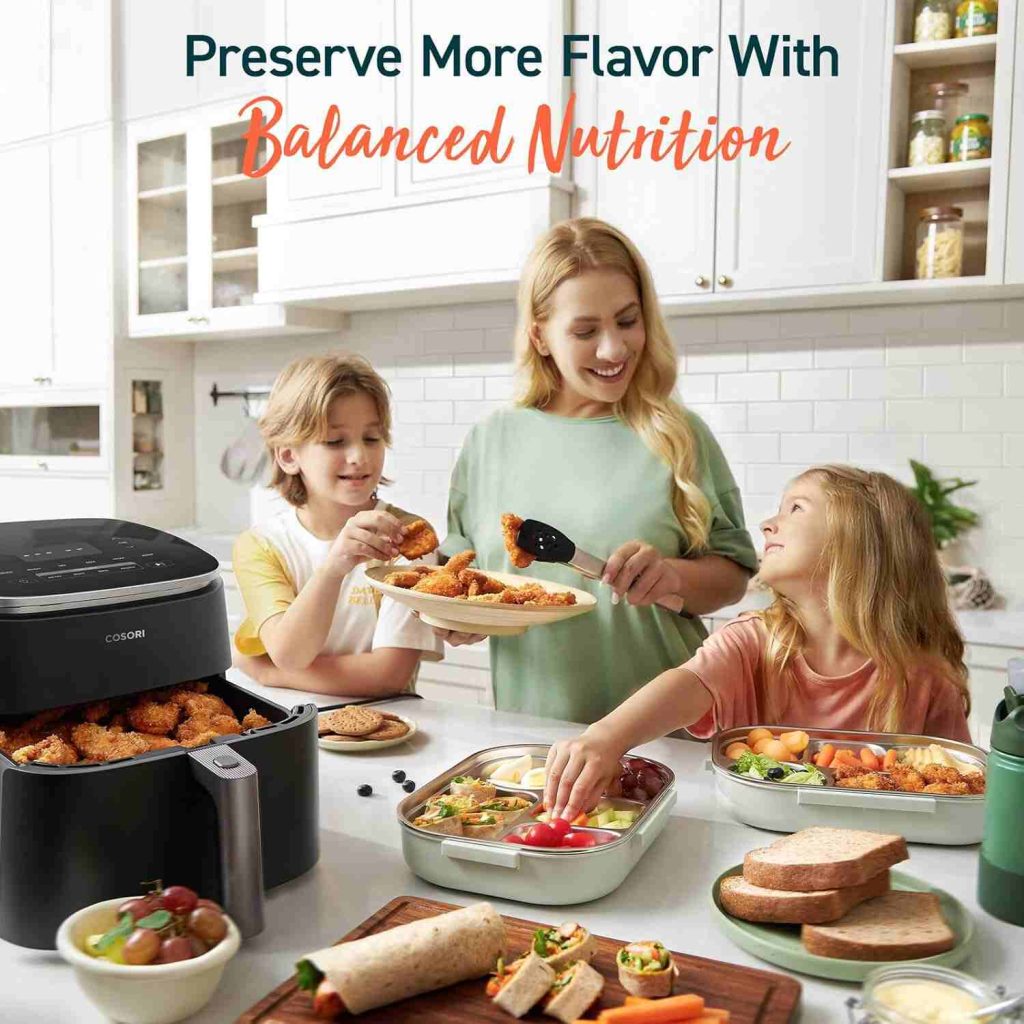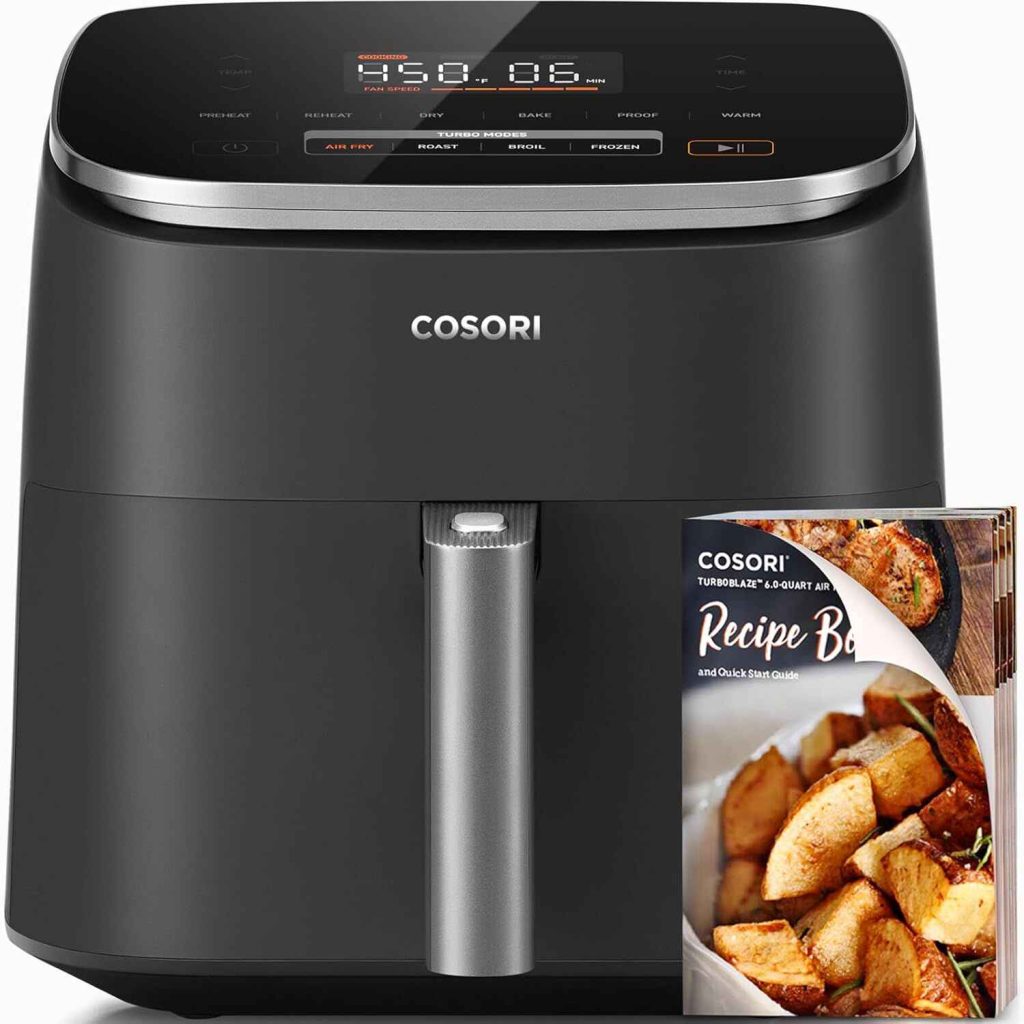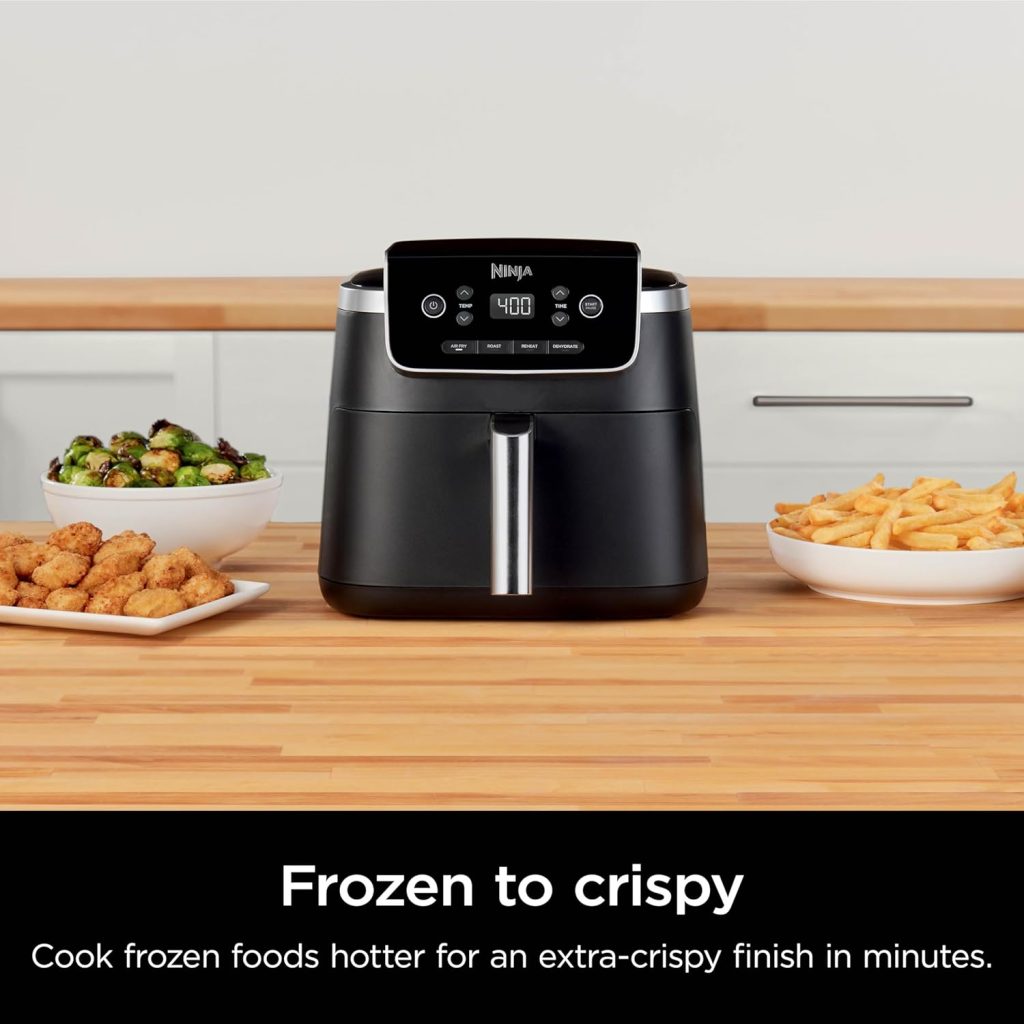Introduction:
How To Use An Air Fryer have become one of the most popular kitchen appliances, offering a healthier alternative to traditional frying. They cook food by circulating hot air around it, creating a crispy layer without the need for excessive oil. If you’re new to air frying, this guide will walk you through everything you need to know to get started.

1.Understanding Your Air Fryer
Before you begin cooking, it’s important to familiarize yourself with the components of your air fryer:
Basket/Tray: This is where the food is placed. It usually has a non-stick coating and may come with a separator to cook multiple items simultaneously.
Control Panel: This includes temperature controls, a timer, and sometimes preset cooking options for specific foods.
Heating Element and Fan: Located at the top of the unit, these are responsible for circulating hot air around your food, ensuring it cooks evenly.
2.Initial Setup and Preheating
Placement: Place your air fryer on a flat, heat-resistant surface with enough space around it for proper ventilation.
Cleaning: Wash the basket or tray with warm, soapy water before the first use to remove any manufacturing residue.
Preheating: Some recipes require preheating. To do this, set the air fryer to the desired temperature and let it run for 3-5 minutes without food.
3.Choosing the Right Temperature and Time
Air fryers typically operate between 180°F to 400°F (82°C to 204°C). The cooking time and temperature depend on the type and quantity of food:
Vegetables: 350°F to 375°F for 10-15 minutes.
Chicken Wings: 375°F for 20-25 minutes.
French Fries: 400°F for 15-20 minutes.
Fish: 350°F for 8-12 minutes.
It’s important to shake or turn the food halfway through cooking to ensure even crisping.
4.Preparing Your Food
Dry the Food: Excess moisture can prevent the food from becoming crispy. Pat your food dry with a paper towel before placing it in the basket.
Oil: While air fryers require less oil than traditional frying, a light coating of oil can help achieve a crispy texture. Use a brush or spray bottle to evenly coat the food with a small amount of oil.
Seasoning: Season your food before placing it in the air fryer. The hot air circulation helps the spices adhere to the food, enhancing flavor.
5.Cooking Process
Loading the Basket: Place the food in the basket or tray, ensuring it’s spread out in a single layer. Overcrowding can lead to uneven cooking.
Setting the Controls: Use the control panel to set the appropriate temperature and time. If your air fryer has presets, you can use those for common foods like chicken, fries, or fish.
Shaking the Basket: For foods like fries or vegetables, shake the basket halfway through cooking to ensure even crisping. For larger items like chicken breasts or steaks, flip them with tongs.
Checking for Doneness: Use a meat thermometer to check the internal temperature of meats or fish. For other foods, look for a golden-brown color and a crispy texture.
6.Post-Cooking Steps
Cooling: Allow the food to cool for a few minutes after cooking. The outside will remain crispy, while the inside stays juicy.
Cleaning: Once the air fryer has cooled, remove the basket or tray and clean it with warm, soapy water. Some components may be dishwasher-safe, but always refer to your air fryer’s manual for specific instructions.
Storage: Store your air fryer in a dry place. If you use it frequently, keeping it on your countertop may be more convenient.
7.Tips and Tricks
Avoid Overcrowding: Overloading the basket can result in uneven cooking. Cook in batches if necessary.
Use Parchment Paper: To prevent sticking and make cleanup easier, you can use perforated parchment paper liners specifically designed for air fryers.
Experiment with Recipes: The air fryer is versatile and can be used for more than just frying. Try baking, roasting, or even grilling in your air fryer. There are countless recipes available to explore.
Monitor Cooking Times: Air fryer cooking times can vary based on the model and the food you’re cooking. It’s better to start with shorter cooking times and add more as needed.
8.Common Mistakes to Avoid
Skipping Preheating: If a recipe calls for preheating, don’t skip this step. Preheating ensures that food cooks evenly and reaches the desired texture.
Using Too Much Oil: While a little oil helps with crisping, using too much can lead to soggy food. A light spritz or brush is usually enough.
Neglecting Maintenance: Regular cleaning of your air fryer, especially the heating element and fan, is crucial for optimal performance and preventing odors.
9.Conclusion
Using an air fryer is a simple and effective way to prepare delicious, healthier meals. With a bit of practice and creativity, you can master this versatile appliance and enjoy a wide range of dishes. Whether you’re making crispy fries, juicy chicken, or roasted vegetables, the air fryer will quickly become a favorite tool in your kitchen.
Why does my food fly around in the air fryer?
Air fryers are known for their ability to create crispy, delicious food with less oil. However, a common issue that some users encounter is food flying around inside the air fryer during cooking. This phenomenon can be perplexing and may even lead to uneven cooking or messy results. Let’s explore the reasons behind this and how you can prevent it.

1.Understanding the Air Fryer’s Mechanism
An air fryer operates by circulating hot air at high speeds around the food, similar to a convection oven. This rapid airflow is what gives food its crispy exterior without the need for deep frying. The powerful fan that drives this air circulation can sometimes cause lightweight food items to become airborne, especially if they are not properly secured or weighed down.
2.Common Causes of Food Flying in the Air Fryer
Lightweight Items: Foods like leafy greens, small pieces of bread, or thin slices of vegetables are more likely to fly around because they have little weight. The strong air current can easily lift them off the basket or tray.
Overcrowding the Basket: When the basket is overcrowded, some pieces may be closer to the fan at the top of the air fryer. These pieces are more susceptible to being blown around due to the concentrated airflow.
Excessive Airflow: Some air fryers have particularly strong fans, which can cause even moderately heavy items to move around if they’re not arranged properly.
Lack of Moisture or Oil: Extremely dry food items, especially those without any oil coating, can become lighter as they cook and dry out further, making them more prone to being tossed around by the airflow.
3.Potential Issues Caused by Flying Food
Uneven Cooking: When food flies around, it may not stay in contact with the basket or tray long enough to cook evenly, leading to some parts being overcooked and others undercooked.
Burning: Lightweight items that come into contact with the heating element can burn quickly, resulting in an unpleasant taste and smell.
Mess Inside the Air Fryer: When food moves around, it may splatter against the walls or the heating element, leading to a mess that requires extra cleaning.
4.How to Prevent Food from Flying Around
Weigh Down the Food: For lightweight items, consider placing a trivet, metal rack, or another oven-safe item on top of the food to hold it in place. You can also use a skewer to secure the food in the basket.
Use a Mesh Cover or Rack: Some air fryer models offer accessories like mesh covers or racks that can be placed over the food. These accessories allow air to circulate while preventing food from becoming airborne.
Coat with a Light Layer of Oil: Adding a small amount of oil can help add weight to your food and prevent it from becoming too light during cooking. It also helps with crisping and adds flavor.
Properly Arrange the Food: Avoid overcrowding the basket, and try to arrange the food in a single layer. This allows the air to circulate evenly and reduces the chances of pieces getting caught in the airflow.
Choose the Right Foods: Some foods are simply too light to cook well in an air fryer without additional preparation. If you’re trying to cook very lightweight items, consider using an alternative cooking method or modifying the recipe to include heavier ingredients.
5.Final Thoughts
While food flying around in the air fryer can be a frustrating issue, it’s usually easy to fix with a few adjustments. By understanding the causes and taking preventative measures, you can ensure that your food stays in place, cooks evenly, and turns out perfectly every time. Whether you’re air frying vegetables, chips, or other snacks, a little preparation can make a big difference in your cooking experience.
Can butter go in the air fryer?
How To Use An Air Fryer has revolutionized home cooking, offering a convenient and healthier way to enjoy crispy, delicious foods. As more people experiment with this versatile appliance, questions arise about which ingredients can be safely used. One common query is whether butter can be used in an air fryer. In this article, we’ll explore the role of butter in air frying, how to use it effectively, and what precautions to take.
1.Can Butter Be Used in an Air Fryer?
Yes, butter can be used in an air fryer, but with some considerations. While butter is a popular ingredient for adding flavor and moisture to various dishes, it behaves differently in an air fryer compared to traditional cooking methods. Understanding these differences is key to achieving the best results.
2.Understanding Butter’s Composition
Butter is primarily composed of fat, with a small amount of water and milk solids. When exposed to high heat, butter can melt quickly, and if the temperature is too high, it can burn. The air fryer’s rapid circulation of hot air can cause butter to melt and spread rapidly, which may lead to smoking, burning, or uneven cooking if not managed properly. Explore affordable air fryers that deliver crispy, delicious results without breaking the bank—perfect for healthier, budget-friendly cooking!
3.How to Use Butter in the Air Fryer
Coating Foods with Butter: One of the most common ways to use butter in an air fryer is to coat food with it before cooking. For example, you can brush melted butter on chicken, fish, or vegetables to enhance flavor and promote browning. Since the air fryer uses less oil than traditional frying, the butter can add a rich, golden crust to your dishes.
Butter in Baking: If you’re baking in the air fryer, butter can be incorporated into doughs, batters, or as a topping. When making items like cookies, pastries, or bread, butter helps to create a tender crumb and adds a rich flavor. Just be mindful of the temperature settings to avoid burning.
Basting During Cooking: Butter can also be used for basting food during the cooking process. For example, you can brush butter onto meats or vegetables halfway through cooking to enhance moisture and flavor. This is particularly useful when cooking items like steaks or grilled vegetables, where you want to achieve a rich, buttery finish.
4.Precautions When Using Butter in the Air Fryer
Avoid Excessive Amounts: While butter can enhance flavor, using too much can cause it to pool at the bottom of the air fryer basket. This can lead to smoking, burning, and even a greasy final product. It’s best to use a light, even coating rather than excessive amounts.
Watch the Temperature: Butter has a low smoke point, typically around 300°F to 350°F (150°C to 175°C). If your air fryer is set to a higher temperature, there’s a risk of the butter burning, which can impart a bitter taste to your food and produce unwanted smoke. Keep the temperature within a moderate range when using butter.
Use Clarified Butter: Clarified butter, or ghee, has a higher smoke point (around 450°F or 230°C) because the milk solids have been removed. This makes it more suitable for high-heat cooking in an air fryer. It’s a great alternative if you want the flavor of butter without the risk of burning.
Proper Ventilation: When using butter in an air fryer, ensure your kitchen is well-ventilated to prevent smoke from accumulating. If your air fryer starts to smoke, lower the temperature or pause cooking to check if the butter has started to burn.
5.Alternatives to Butter in the Air Fryer
If you’re concerned about the smoke point of butter or want to explore other options, there are alternatives that can achieve similar results:
Olive Oil: Olive oil is a popular alternative with a higher smoke point than butter. It’s ideal for air frying and adds a mild, pleasant flavor to dishes.
Avocado Oil: Avocado oil has an even higher smoke point and a neutral flavor, making it a great choice for air frying at high temperatures.
Cooking Sprays: Light cooking sprays can be used to coat foods before air frying. They are convenient and help achieve a crisp texture without adding excessive fat.
6.Final Thoughts
Butter can absolutely go in the air fryer, but it requires careful handling to avoid burning and smoking. By using it in moderation, keeping an eye on temperature settings, and considering alternatives like clarified butter, you can enjoy the rich flavor and golden finish that butter brings to your air-fried dishes. Whether you’re coating vegetables, basting meats, or baking treats, butter can be a delicious addition to your air fryer cooking repertoire. Discover the versatility of air fryer toaster ovens for crispy, healthy meals with easy-to-use, multifunctional features.

Are wooden skewers safe in the air fryer?
Cooking with an air fryer opens up a world of possibilities, from crispy fries to perfectly roasted vegetables. But when it comes to using wooden skewers in this versatile appliance, some home cooks may wonder if it’s safe. Wooden skewers are commonly used for grilling and roasting, but can they handle the high temperatures and rapid air circulation of an air fryer? Let’s explore the safety and best practices for using wooden skewers in an air fryer.
1.Can Wooden Skewers Be Used in the Air Fryer?
Yes, wooden skewers can be safely used in an air fryer, but certain precautions should be taken to ensure they don’t burn or cause any issues during cooking. While air fryers are different from traditional grills or ovens, they can still accommodate wooden skewers if used correctly.
2.Understanding the Risks
Burning: Wooden skewers are prone to burning, especially when exposed to high temperatures for extended periods. Air fryers operate at temperatures between 180°F and 400°F (82°C to 204°C), which can cause unsoaked wooden skewers to char or ignite if not properly managed.
Brittleness: If wooden skewers are not soaked or are used repeatedly, they may become brittle and break during cooking, which can be both a safety hazard and a cooking inconvenience.
3.How to Safely Use Wooden Skewers in the Air Fryer
Soak the Skewers: One of the most effective ways to prevent wooden skewers from burning in the air fryer is to soak them in water for at least 20-30 minutes before use. This helps the skewers absorb moisture, making them less likely to char or catch fire during cooking. Soaking is especially important when cooking at higher temperatures or for longer durations.
Cut to Fit: Depending on the size of your air fryer basket, you may need to trim the skewers to fit properly. This not only prevents the skewers from sticking out of the basket, where they might be exposed to the heating element, but it also ensures even cooking.
Arrange Food Evenly: When threading food onto the skewers, ensure that it is evenly distributed. Avoid overcrowding the skewers, as this can lead to uneven cooking and increase the risk of burning where the skewer is exposed.
Monitor Cooking Time: Keep an eye on the cooking process, especially if you’re using wooden skewers for the first time in the air fryer. Check periodically to ensure the skewers aren’t burning, and adjust the temperature or cooking time if necessary.
Use Parchment Paper: If you’re concerned about the skewers burning, you can place a sheet of perforated parchment paper at the bottom of the air fryer basket. This can help shield the skewers from direct exposure to the heating element and reduce the risk of charring.
4.Benefits of Using Wooden Skewers in the Air Fryer
Flavor Infusion: Wooden skewers can impart a subtle, smoky flavor to your food, especially if they are soaked in water mixed with herbs or spices before cooking.
Versatility: Wooden skewers are ideal for making kebabs, satay, and other skewer-based dishes. They allow for even cooking and can be easily flipped or rotated within the air fryer.
Eco-Friendly: Unlike metal skewers, wooden skewers are biodegradable and can be disposed of easily after use, making them an environmentally friendly option.
5.Alternatives to Wooden Skewers
If you’re concerned about the potential risks of using wooden skewers, there are alternatives that may suit your needs better:
Metal Skewers: Metal skewers are reusable and can withstand high temperatures without burning. They are a great option for frequent air fryer users who want a durable solution.
Silicone Skewers: Silicone skewers are another reusable option that can handle high heat. They are flexible, making them easier to fit in smaller air fryer baskets.
Bamboo Skewers: Bamboo skewers are similar to wooden skewers but are often denser and more resistant to burning. They still need to be soaked before use but may offer slightly better durability.
6.Final Thoughts
How To Use An Air Fryer Wooden skewers can be safely used in an air fryer with the right precautions. By soaking them before use, monitoring the cooking process, and considering the size and arrangement of the food on the skewers, you can enjoy delicious, evenly cooked dishes without the risk of burning. Whether you’re making kebabs, skewered vegetables, or other tasty treats, wooden skewers remain a versatile and convenient tool in air fryer cooking.
As an Amazon Associate, We earn from qualifying purchases. When you purchase a product through Amazon links on kitchenadvising.com, we may earn a small commission at no extra cost to you. This helps support the site and keep our content free.


